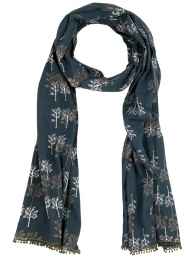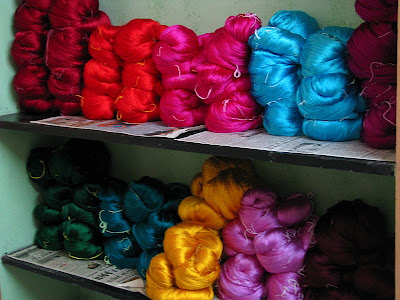Oder: Indischer Dresscode für Beginner ||
Or: Indian dress code for beginners
Meine Freundin V aus Indien liebt verrückte Farbkombinationen genauso sehr wie ich. Orange und pink? Lila und orange? Rot und Lila! Ja, bitte! So eine Kurta will ich auch :)
My friend V from India loves crazy colour combinations as much as I do. Orange and pink? Purple and orange? Red and purple! Yes, please! I want a kurta likes this :)
V erklärt: "In dieser Kurta (dem Oberteil) passen all die kräftigen Farben richtig gut zusammen - und das weiße Unterteil sagt: "peace out!". Solche Farben passen richtig gut zu dem heißen Sommer hier in Delhi!" Recht hat sie - und wenn ihr das nicht so seht, dann macht euch auf den Weg nach Südasien. Würd mich nicht wundern, wenn ihr nach ein paar Wochen genauso verrückt nach kräftigen Farben seid wie wir. :)
V explains: "In this kurta (the top part) all bright colours are in harmony and white bottom says peace out! And this colour works fine in hot summer like Delhi!!" I couldn't agree more - and if you don't, go and spend some time in South Asia. Chances are after a couple of weeks, you'll love your bright colours as much as we do. :)
Eine Sache ist mir jedoch aufgefallen, als ich mir Vs Bild ansah. Aus meiner Zeit in Südasien erinnere ich mich daran, dass dort quasi alle Frauen Dupatta trugen - und wenn es nur ein winziges, durchsichtiges Tuch war. Die Dupatta trugen sie um den Hals wie einen Schal oder ganz lässig über eine Schulter geworfen - und zwar selbst, wenn sie nie im Leben daran denken würden, ihre Haare damit zu bedecken.
One thing struck me though when I saw V's picture. I remember from my time in South Asia most women wearing a dupatta - and if it was just a tiny, transparent scarf. They would wear it around the neck like a shawl or casually thrown over one shoulder, even if they'd never think of covering their hair with it.
Laut V liegt der Unterschied in der Art von Kleidern, die sie trägt - und an dem Ort, an dem sie lebt: "Was die Dupatta angeht - da gibt es hier zwei Möglichkeiten. Wenn du eine Designer-Kurta in knalligen, kräftigen Farben trägst, dann kannst du die Dupatta weglassen - auch wenn sie praktisch sein kann, zum Beispiel als Sonnenschutz. Dann gibt es eine Kleiderkombination, die aus Kurta, Dupatta und Pyjama in zueinander passenden Farben besteht [der Shalwar Kameez] - und ja, in diesem Fall trage ich dann auch eine Dupatta. Die meisten jungen Mädchen hier tragen keine Dupatta, und selbst einige der älteren Frauen nicht - generell ist die Dupatta für ältere Frauen allerdings immer noch ein Muss. Bei der Kurta geht es einfach nur darum, sich gut zu fühlen und Spaß zu haben. Hier tragen nicht alle Muslime Hijab / Niqab, eigentlich tun das hier nur sehr, sehr wenige Leute. Selbst muslimische Mädchen tragen hier in den größeren Städten keine Dupatta, aber in kleinen Städten und auf dem Land, ist die Dupatta ein Muss für Frauen jeder Altersgruppe."
According to V, what makes the difference here is the kind of clothes she is wearing - and the place where she lives: "Regarding the dupatta - here, these are worn two ways, if your kurta
is bright and designer, you can avoid wearing a dupatta, although
dupatta comes handy from sun protection. There are certain dresses where
its a whole set of kurta, dupatta and pyjama with matching colours [the shalwar kameez], so
yes there i like to wear dupatta. Here, mostly young girls wear
without dupatta and even few older ladies otherwise this dupatta
concept is sort of must wear for middle-aged and elder ladies. It's all
about having fun with the kurta. Here, all Muslims don't wear
hijab / naqab, very very few people do. Even Muslim girls wear without
dupatta in urban cities, but in small towns and rural places, dupatta is
must wear for all age groups."
.
.



















